Understanding tree seed pods is essential for identifying species, as their unique shapes, sizes, and textures provide vital clues. This guide helps enthusiasts and botanists alike recognize and classify tree seed pods effectively, offering insights into their ecological significance and role in forest biodiversity.
Understanding the Importance of Seed Pods in Tree Identification
Seed pods are indispensable in tree identification, offering unique characteristics that distinguish species. Their shapes, sizes, textures, and colors vary widely, providing clear markers for classification. Unlike leaves or bark, seed pods often remain on trees longer, aiding identification even in seasons when foliage is scarce. They reveal ecological roles, such as seed dispersal methods, and are crucial for understanding forest regeneration. By examining seed pods, botanists and enthusiasts can accurately identify tree species, complementing observations of leaves, bark, and flowers. This method is particularly valuable for species with less distinctive foliage, making seed pods a vital tool in comprehensive tree identification processes.
Overview of Common Tree Seed Pod Types
Tree seed pods come in various forms, each with distinct characteristics. Common types include samaras, such as those from maple and ash trees, which have wing-like structures for wind dispersal. Cones are typical of conifers, with scales that protect seeds until release. Legumes, like those from acacia and honey locust, are elongated pods that split open to release seeds. Other types include catkins, follicles, and capsules. Each pod type has unique features, such as shape, size, and texture, aiding in identification. These structures not only protect seeds but also play a role in dispersal, reflecting the tree’s ecological adaptations. Understanding these types is key to effective tree identification and appreciation of their diversity.
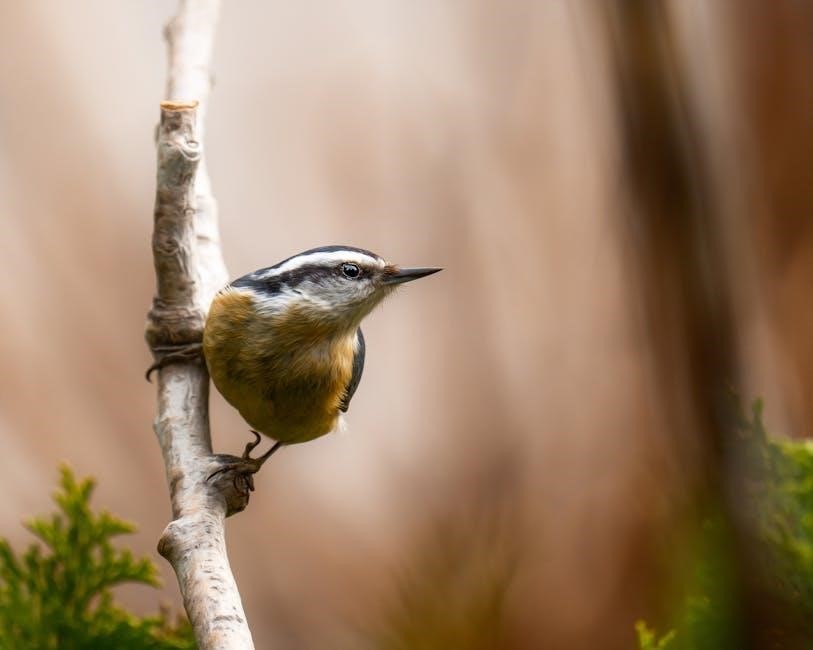
Common Types of Tree Seed Pods
Common types of tree seed pods include samaras, cones, and legumes, each with unique shapes and functions that aid in seed dispersal and protection, key to identification and ecological roles.
Samaras: Winged Seeds like Maple and Ash
Samaras, or winged seeds, are a distinctive feature of trees like maple and ash. These seeds have a unique wing-like structure that aids in wind dispersal. Maple samaras are commonly recognized by their V-shaped wings, while ash trees produce samaras in clusters. The shape, size, and venation of the wings are crucial for identification. For instance, the Norway maple has larger wings compared to the sugar maple. These structures not only facilitate seed spread but also offer a key characteristic for distinguishing species; Observing the wing’s attachment point and overall form can help enthusiasts accurately identify these seed pods in the field.
Cones: Identifying Conifer Seed Pods
Cones are the seed pods of coniferous trees, such as pines, spruces, and firs. They are woody structures that protect seeds during development. Pine cones are large, with scales that open to release seeds, while spruce and fir cones are smaller and more cylindrical. The texture and arrangement of scales vary between species, aiding identification. For example, pine cones often have rigid, woody scales, whereas fir cones are softer and disintegrate at maturity. The size, shape, and seed release method of cones are key features for distinguishing conifer species. Observing these details helps in accurately identifying the tree and understanding its seed dispersal strategy.
Legumes: Pods from Trees like Acacia and Honey Locust
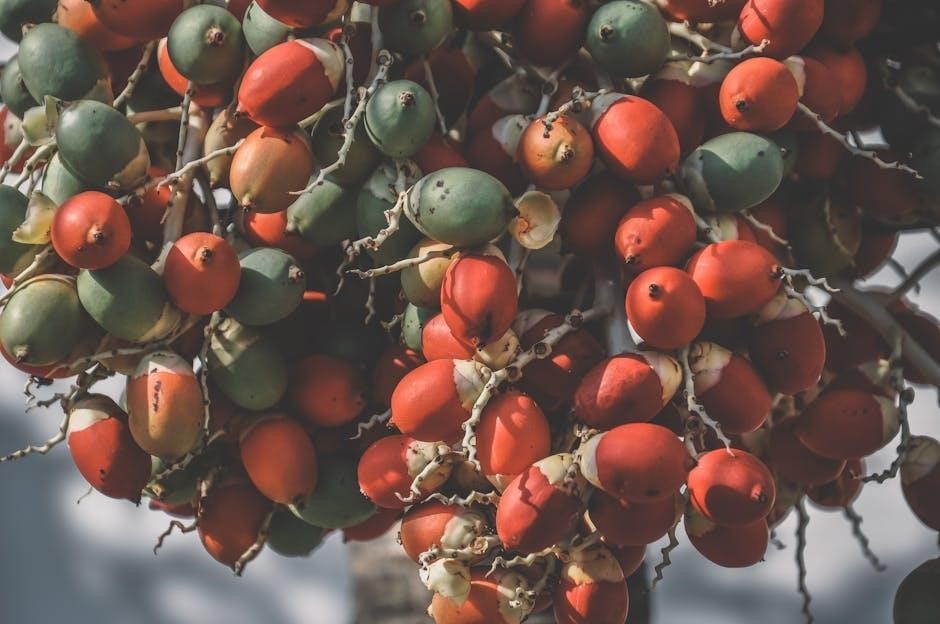
Legume pods are a distinctive feature of certain tree species, including Acacia and Honey Locust. These pods are elongated, flat, and typically contain multiple seeds. Acacia pods are often curved or twisted, with a leathery texture, while Honey Locust pods are long and straight, sometimes reaching up to 18 inches in length. The pods split open to release their seeds, which are surrounded by a sweet, edible pulp in some species. The unique shape, size, and seed arrangement within legume pods make them a reliable characteristic for identifying these trees. Their appearance and structure are crucial for distinguishing between different legume-producing species.
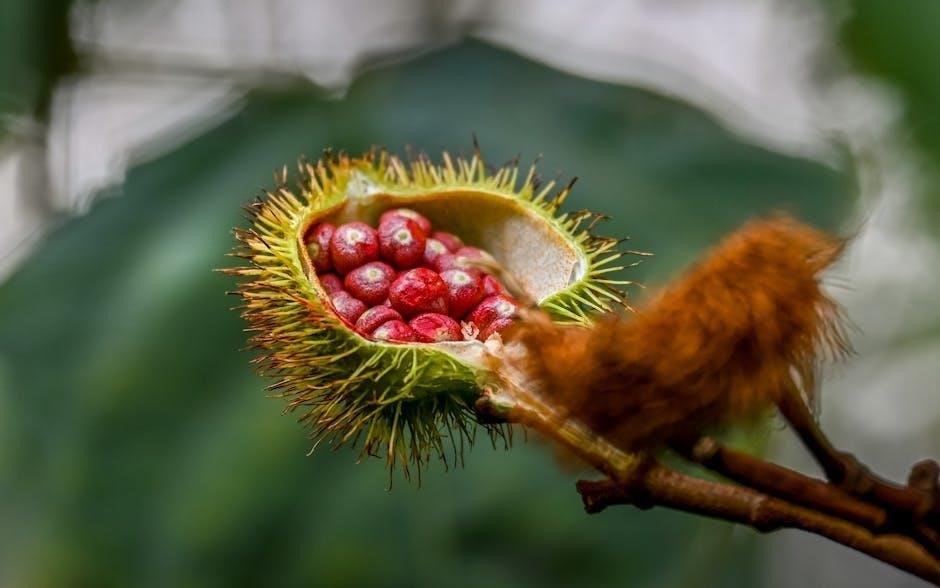
Identifying Specific Tree Species by Seed Pods
Seed pods offer unique traits for identifying tree species, such as shape, size, and seed arrangement, helping distinguish between varieties like Maple, Ash, and Acacia effectively.
Maple Trees: Distinguishing by Seed Wing Shape
Maple trees are easily identified by their distinctive seed pods, known as samaras, which feature a unique wing shape. The wings vary in size and angle, aiding species differentiation. Red Maple and Sugar Maple have broader, more angled wings, while Silver Maple samaras are narrower and droop downward. The wing’s attachment point to the seed also differs, with some species exhibiting a more pronounced notch. These variations allow enthusiasts to accurately distinguish between Maple species. Observing the samaras’ arrangement on the tree further enhances identification, as they often grow in pairs or clusters. This method is particularly effective when leaves or bark are less visible, making seed pods a reliable tool for Maple tree identification.
Ash Trees: Recognizing Key Characteristics
Ash trees produce seed pods that are flat, oval, and papery, resembling dried leaves. These pods, known as samaras, hang in clusters from branches, making them highly visible. The pods are typically pale brown and have a distinctive vein-like pattern. The shape and texture are key identifiers, as they differ from other tree species. Ash tree samaras are also relatively large, measuring up to several centimeters in length. Their papery texture and the way they hang in bunches are defining features. By closely examining these characteristics, enthusiasts can reliably identify Ash trees, even when other features like leaves are absent. This method is especially useful during seasons when foliage is scarce.
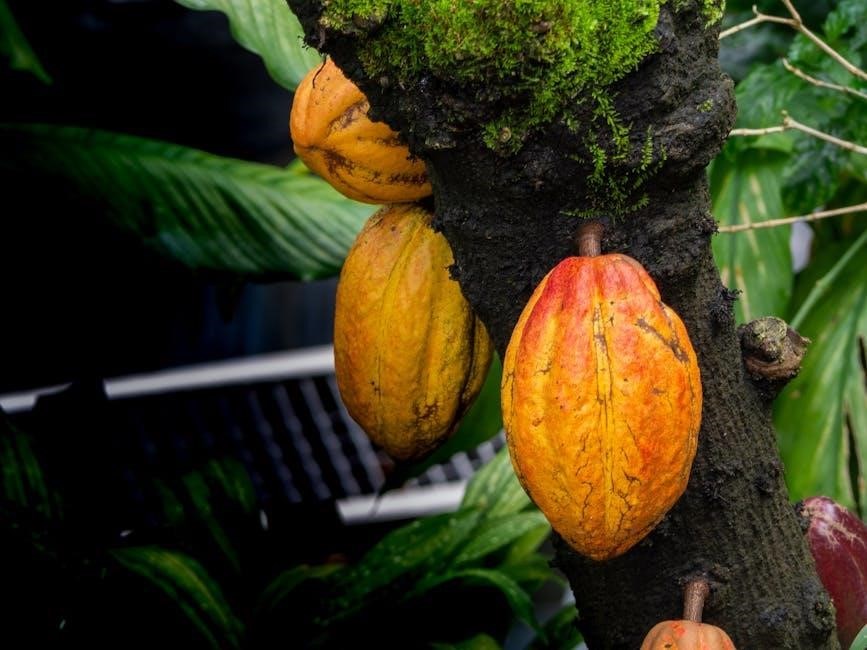
Acacia Trees: Unique Pod Features
Acacia trees are known for their distinctive seed pods, which are often legume-like in appearance. These pods are typically flat, elongated, and vary in color from brown to black. They are covered in a tough, woody texture that protects the seeds inside. Unlike other tree pods, Acacia pods often split open to release seeds, which are small and round. Some species have pods with a twisted or curled shape, adding to their unique appearance. The size and texture of Acacia pods make them easily identifiable, especially when compared to smoother or winged pods from other trees. These pods play a crucial role in seed dispersal, ensuring the survival of the species in diverse environments.
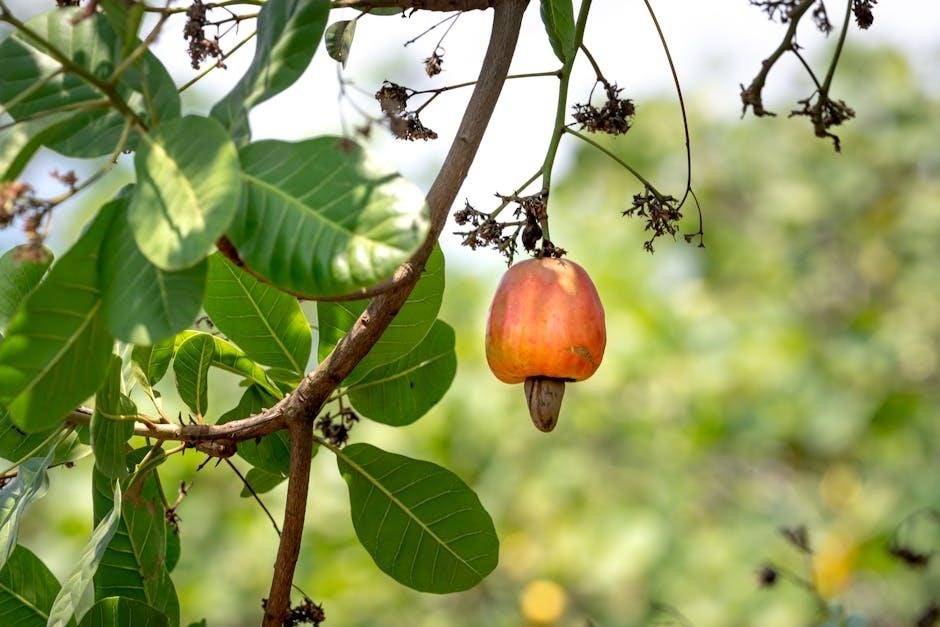
Key Characteristics for Seed Pod Identification
Key characteristics include shape, size, texture, and color, aiding in accurate identification. Observing how seeds are released also provides crucial clues about the tree species.
Shape: Variations in Pod Forms
Seed pods exhibit remarkable diversity in shape, from the elongated, flattened pods of legumes to the spherical, berry-like structures of some conifers. Maple trees produce samaras, winged seeds that resemble tiny helicopters, while ash trees have papery, oval pods. Acacia trees often have pods that spiral or coil, adding uniqueness to their form. The shape of a seed pod is one of the most immediate and noticeable features, making it a critical factor in identification. By closely examining the pod’s outline and structure, enthusiasts can narrow down potential species and gain deeper insights into the tree’s biology and ecological role.

Size: Measuring Pods for Accurate ID
Seed pod size is a crucial factor in identification, as it varies significantly across species. Small pods, like those of orchids, may be barely noticeable, while larger ones, such as magnolia pods, can grow several inches long; Maple seeds, for instance, are relatively small, while ash pods are longer and more slender. Measuring pods helps distinguish between similar species, as even slight differences in length or width can be telling. By noting these dimensions, enthusiasts can more accurately identify tree species, especially when combined with observations of shape, texture, and color. Size provides a foundational clue in the identification process;
Texture: Smooth, Prickly, or Papery Pods
Seed pod texture is a key identifier, varying from smooth to prickly or papery. Smooth pods, like those of magnolia, have a sleek surface, while prickly pods, such as honey locust, feature sharp, protective spines. Papery pods, like ash, are lightweight and delicate. Some pods may also have ridges or scales. Texture often reflects the pod’s maturity and species origin. For instance, young pods might be tender, while mature ones may harden. By examining the texture, enthusiasts can gain insights into the pod’s function and the tree’s ecological adaptations. This characteristic, combined with others, aids in precise identification and highlights the diversity of seed pod structures.
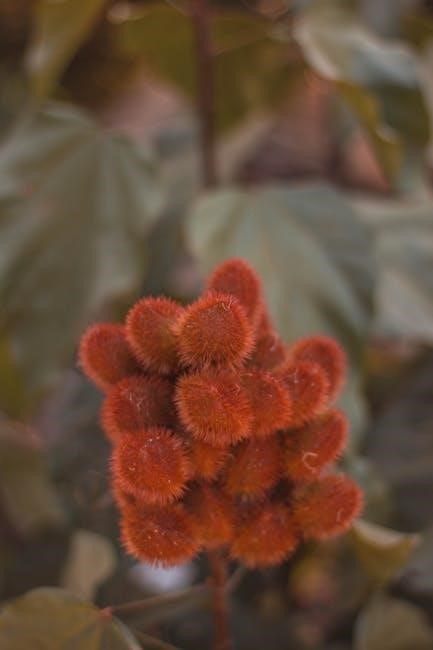
Color: Identifying Pods by Hue and Patterns
Color plays a crucial role in seed pod identification, offering significant clues about species and maturity. Pods can range from vibrant hues like red, orange, and yellow to more muted tones such as brown, green, and purple. Patterns like stripes or mottling further enhance identification. For example, the bright red pods of the invasive tree of heaven contrast sharply with the earthy tones of native species. Seasonal changes also affect color, as pods often shift from green to brown as they mature. By noting both color and pattern, enthusiasts can distinguish between similar species and gain a deeper understanding of a tree’s life cycle and ecological role.
Ecological Role of Tree Seed Pods
Tree seed pods play a vital ecological role by protecting seeds, aiding dispersal, and promoting forest regeneration. They also serve as a food source for various wildlife species.
Seed Dispersal Methods
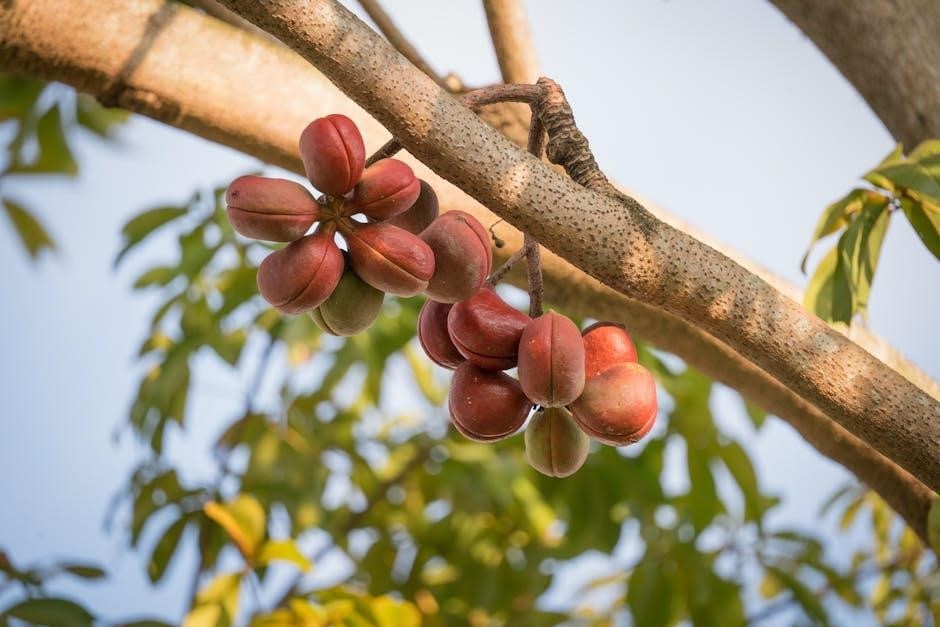
Tree seed pods play a crucial role in seed dispersal, ensuring the spread of species across various habitats. Wind, water, and animals are primary dispersal agents. Winged seeds, like those of maple and ash, glide through the air, covering vast distances. Cones from conifers release seeds that fall near the tree or are carried by wind. Legumes, such as those from acacia trees, may burst open, scattering seeds. Water dispersal occurs with buoyant pods, such as coconut husks, which float to new locations. Animals also contribute by consuming fruits or pods, later depositing seeds in new areas, often with nutrient-rich soil. These methods ensure species survival and forest diversity.
Forest Regeneration and Pod Characteristics
Tree seed pods are vital for forest regeneration, as they protect and disperse seeds, ensuring the survival of species. Pods vary in shape, size, and structure, adapting to specific environments. Some pods, like samaras, rely on wind for dispersal, while others, such as legumes, burst open to release seeds. The characteristics of pods influence germination and growth, with some requiring specific soil conditions. Larger pods often indicate trees adapted to nutrient-rich environments, while smaller pods may thrive in diverse settings. These adaptations ensure forests maintain biodiversity, as different species occupy unique ecological niches. Understanding pod traits aids in conservation and sustainable forest management.
Using Seed Pods with Other Identification Features
Combining seed pod observations with leaf, bark, and flower traits enhances identification accuracy. This holistic approach ensures a more reliable species determination, especially when pods are absent or seasonal.
Combining Leaf, Bark, and Pod Observations
For accurate tree identification, combining leaf, bark, and seed pod observations is crucial. Leaves provide clues about shape, margin, and venation, while bark offers insights into texture and patterns. Seed pods, with their unique forms and textures, add another layer of detail. For example, maple trees have distinctive lobed leaves and samara pods, while ash trees display compound leaves and papery pods. By cross-referencing these features, enthusiasts can overcome challenges like seasonal pod absence. This integrated approach ensures a more reliable determination of species, especially when individual traits are ambiguous or variable. Together, these elements paint a comprehensive picture of a tree’s identity.


